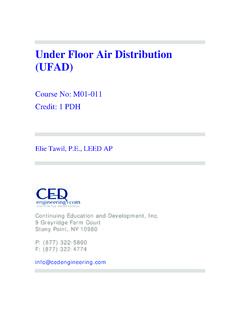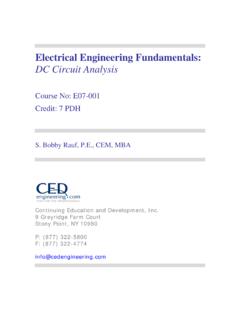Transcription of HVAC Design for Cleanroom Facilities - CED Engineering
1 HVAC Design for Cleanroom Facilities Course No: M06-008 Credit: 6 PDH A. Bhatia Continuing Education and Development, Stonewall CourtWoodcliff Lake, NJ 07677P: (877) FOR Cleanroom Facilities Indoor air quality is of paramount importance for human comfort and health. Air, whether it is from outside or re-circulated within the area, acts as a vehicle for airborne contaminants brought in by the movement of people, material, etc. Since many of these airborne contaminants are harmful either to products or people working in such environments their removal is necessary on medical, legal, social or financial grounds. Cleanrooms are specially constructed, environmentally controlled enclosed spaces where the concentration of airborne particles (contaminants) is kept within specified limits. In industry, cleanrooms are used in the manufacturing of electronic hardware such as integrated circuits (ICs) and hard drives.
2 In biotechnology and medicine, cleanrooms are used when it is necessary to ensure an environment free of bacteria, viruses, or other pathogens. Four fundamental rules apply to cleanrooms. 1) First, contaminants must not be introduced into the controlled environment from the outside. 2) Second, the apparatus or equipment within the controlled environment must not generate or otherwise give rise to contaminants (for example as a result of friction, chemical reactions, or biological processes). 3) Third, contaminants must not be allowed to accumulate in the controlled environment. 4) Fourth, existing contaminants must be eliminated to the greatest extent possible, and as rapidly as possible. These requirements are defined in Federal industry standard 209 and ISO 14644-1. It takes an incredible amount of technology to achieve and maintain these objectives.
3 The HVAC system for cleanrooms is a specialized field requiring thorough understanding of cleanliness guidelines, airflow streams, room pressurization, temperature, humidity and filtration requirements, knowledge of codes and standards, specialty equipment, instrumentation and control, and many more details. This course will describe some basic requirements of HVAC Design for Cleanroom applications. Airborne particles Characteristics Airborne particles are solids suspended in the air. For our purposes, particles are defined as bodies with: 1) Definite physical boundaries in all directions. 2) Diameters ranging from micron to 100 microns*. 3) Liquid or solid phase material characteristics. *The size of contaminants and particles are usually described in microns; one micron is one-millionth of a meter. In English units one micron equals 1/25,400 inch.
4 To give a perspective, a human hair is about 75-100 microns in diameter. A particle of micron (200 times smaller than the human hair) can cause major disaster in a Cleanroom . Sources of Contamination The airborne contamination level of a Cleanroom is largely dependent on the particle generating activities in the room, besides the personnel who also contribute to the contamination levels. It has been found that many of these contaminants are generated from five basic sources (1) the Facilities , (2) people, (3) tools, (4) fluids and (5) the product being manufactured. Review the list below to gain a better understanding of where the contamination originates. 1) Facilities Walls, floors and ceilings Paint and coatings Construction material (sheet rock, saw dust etc.) Air conditioning debris Room air and vapors Spills and leaks 2) People Skin flakes and oil Cosmetics and perfume Spittle Clothing debris (lint, fibers etc.
5 Hair 3) Tool Generated Friction and wear particles Lubricants and emissions Vibrations Brooms, mops and dusters 4) Fluids Particulates floating in air Bacteria, organics and moisture Floor finishes or coatings Cleaning chemicals Plasticizers (out-gasses) Deionized water 5) Product generated Silicon chips Quartz flakes Cleanroom debris Aluminum particles This is a partial list of some of the commonly known contaminants. Preventing these contaminants from entering the Cleanroom environment is the key objective of Cleanroom Design and use. What is a Cleanroom ? A Cleanroom is defined by ISO14644-1 as a room in which the concentration of airborne particles is controlled, and which is constructed and used in a manner to minimize the introduction, generation, and retention of particles inside the room and in which other relevant parameters, temperature, humidity, and pressure, are controlled as necessary.
6 Cleanroom Classification Cleanroom specifications for particulate matter (such as dust) are defined according to the maximum allowable particle size (diameter), and also according to the maximum allowable number of particles per unit volume. For non-particulate contaminants, the maximum allowable density in terms of microbes per cubic meter, or molecules per cubic meter, is specified. The determination of how clean an area is depends on the class number that it is designed to. According to Federal Standard 209, A to D versions, class number refers to the maximum number of particles of micron size or bigger that would be allowed in one cubic foot of Cleanroom air. Maximum number of particles in Air (particle per cubic feet of air) Class m m m m 5 m 1 35 7 3 1 10 350 75 30 10 100 3500 750 300 100 1,000 1,000 7 10,000 10,000 70 100,000 100.
7 000 700 A Class 100 Cleanroom , for example, would not contain more than 100 particles bigger than micron in a cubic foot of air. A Class 10,000 - Particle count not exceeding a total of 10,000 particles per cubic foot of a size microns and larger or 70 particles per cubic foot of a size microns and larger. Classes and their Typical Uses Class 1 & 10 - production laboratories for electronic integrated Class 100 - production areas for photo labs, medical Class 10,000 - production locales for TV tubes, hospital operating Class 100,000 - production of ball ISO Classification of Cleanrooms ISO 14644 classification for cleanrooms is based on the formula Cn = 10N ( / D) Where Cn = maximum permitted number of particles per cubic meter equal to or greater than the specified particle size, rounded to whole number N = is the ISO class number, which must be a multiple of and be 9 or less D = is the particle size in micrometers Maximum Concentration Limits (particles/m3 of air)
8 Class m m m m 1 m 5 m ISO 1 ISO 2 ISO 3 ISO 4 ISO 5 ISO 6 ISO 7 ISO 8 ISO 9 10 100 1000 10000 100000 1000000 2 24 237 2370 23700 237000 10 102 1020 10200 102000 4 35 352 3520 35200 352000 3520000 35200000 8 83 832 8320 83200 832000 8320000 29 293 2930 29300 293000 An ISO 1 Cleanroom has the lowest levels of contamination, while an ISO 9 has the highest allowable level. To give a perspective, the ambient air outside in a typical urban environment might contain as many as 35,000,000 particles per cubic meter, um and larger in diameter, corresponding to an ISO class 9 Cleanroom . Cleanroom class comparison (ISO v/s Federal Std. 209) ISO is based on metric measurements whereas Federal Standard 209 is based on imperial measurements. The classes, according to ISO14644, are in terms of class levels 3, 4, airborne particulate cleanliness corresponding to 1, 10, Fed 209 standards.
9 A Class 5 means that less than 3,520 particles ( microns in size) are present per cubic meter, which equals 100 particles per cubic foot. ISO Federal Std. 209* ISO 3 1 ISO 4 10 ISO 5 100 ISO 6 1,000 ISO 7 10,000 ISO 8 100,000 *In United States, Federal Standard 209E (FED-STD-209E) was used until the end of November 2001 to define the requirements for cleanrooms. On November 29, 2001, these standards were superseded by the publication of ISO specification 14644. Key Elements of Cleanroom Design Four basic components define a controlled environment: 1) Cleanroom Architecture Materials of construction and finishes are important in establishing cleanliness levels and are important in minimizing the internal generation of contaminants from the surfaces. 2) The HVAC System The integrity of the Cleanroom environment is created by the pressure differential compared with adjacent areas through heating, ventilation and air-conditioning system.
10 The HVAC system requirements include: Supplying airflow in sufficient volume and cleanliness to support the cleanliness rating of the room. Introducing air in a manner to prevent stagnant areas where particles could accumulate. Filtering the outside and re-circulated air across high efficiency particulate air (HEPA) filters. Conditioning the air to meet the Cleanroom temperature and humidity requirements. Ensuring enough conditioned makeup air to maintain the specified positive pressurization. 3) Interaction Technology - Interaction technology includes two elements: (1) the movement of materials into the area and the movement of people and (2) maintenance and cleaning. Administrative instructions, procedures and actions are necessary to be made about the logistics, operation strategies, maintenance and cleaning.











